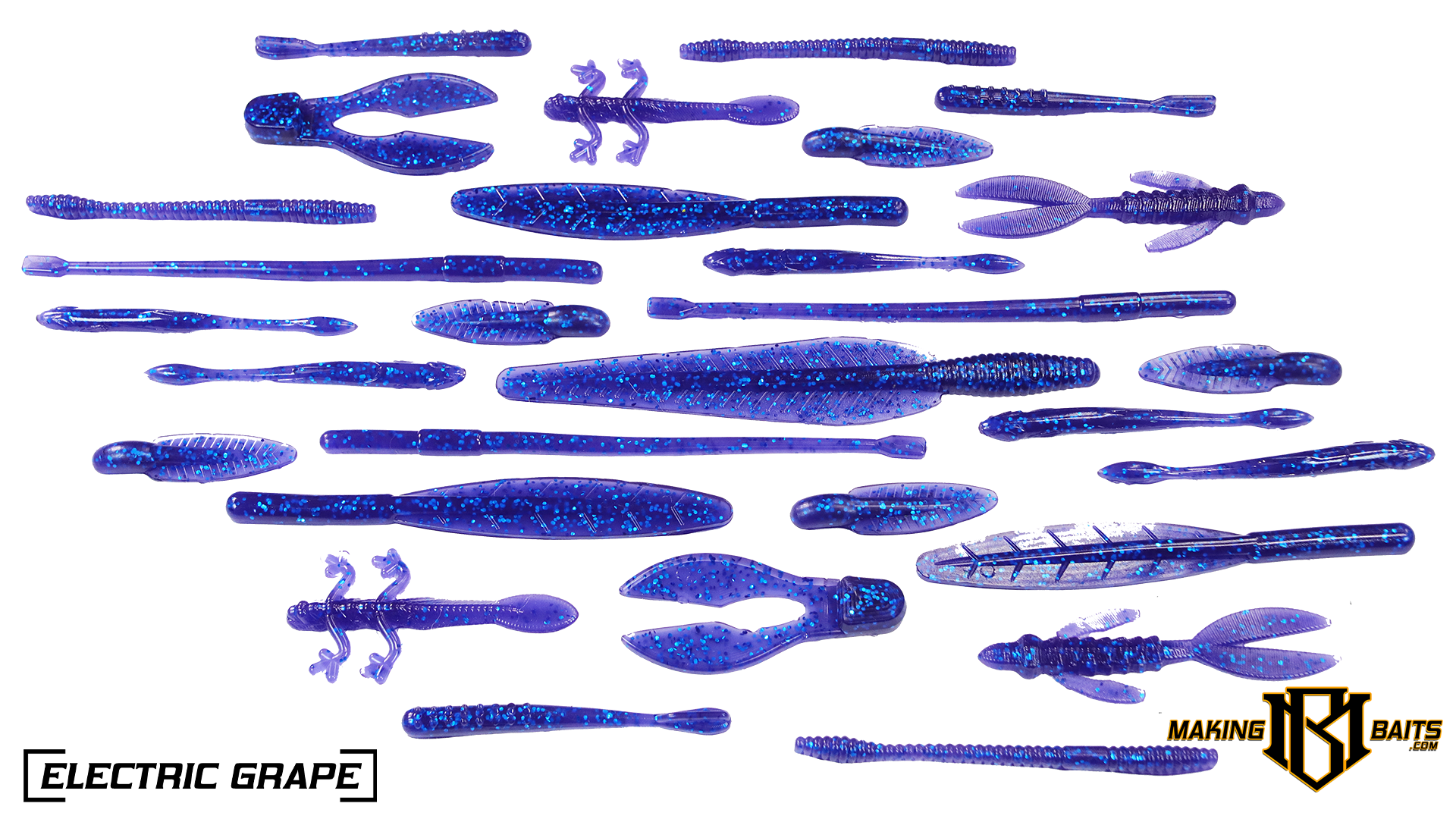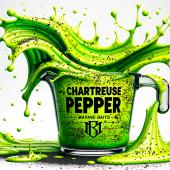Electric Grape: Get Amped with This Electrifying Bass Magnet!
Purple-colored soft plastics have been a mainstay in bass fishing since the inception of soft plastic lures. Despite the rainbow of colors now at an angler's disposal, classic shades like Black Grape, June Bug, and Electric Grape remain essentials in tackle boxes around the globe. Today, we're focusing on recreating the Electric Grape color, also known among enthusiasts as Electric Purple, a hue that consistently proves its worth in the water.
In the past, achieving these iconic colors required bait makers to mix two to three different colorants, a process that often led to inconsistencies across batches. Nowadays, thanks to advancements in bait-making technology and materials, reproducing these colors is simpler and more reliable. Dead On Plastix's premixed Electric Grape colorant exemplifies this progress, offering bait makers an easy way to achieve a vibrant purple hue with the desired intensity and translucency by adjusting the amount of colorant used. For a standard recipe, we suggest using 35 drops of Electric Grape colorant mixed into 1 cup of plastisol.

To add character and a spark of vibrancy to the bait, incorporating 1/4 teaspoon of medium blue glitter does the trick, giving the bait an "electric" flair. If you're aiming for a more pronounced "blue flash" effect, consider increasing the glitter to 1/2 teaspoon. Adding a touch of silver glitter alongside the blue can introduce an additional layer of allure, mimicking the natural reflections of fish scales under sunlight.
This Electric Grape recipe is particularly effective in murky, muddy, or slightly stained waters, attracting bass with its distinct color and sparkle. For an added visual punch and to enhance its appeal, pairing it with a chartreuse tail accent can make it even more irresistible to fish, offering the perfect contrast to trigger strikes.
By following this guide, you're equipping yourself with a proven bass magnet. The Electric Grape color not only pays homage to the enduring popularity of classic hues but also leverages modern bait-making advancements for consistency and effectiveness. It's a testament to how traditional colors can be revitalized for contemporary fishing, ensuring they remain go-to choices for anglers seeking reliable results.






Recipe Notes
- Adjust the hue and translucency of the bait by adding fewer drops of the liquid colorant for a less saturated and opaque bait. Adding more drops will increase the color saturation and opacity of the bait.
- When adding powdered pigment, less is always more. Adding a single drop of black colorant will help the powdered pigment’s “pearl” effect “pop” more.
- For a slightly different presentation add 5-10 drops of Dead On Plastics Snowshine, Joker, or Dorothy Pearl Effects Colorants. These colorants will add a “sheen” to the bait.
- String-cut glitter/flake likes to curl at temperatures not too far above 300f, so keep this in mind, and check the plastisol's temperature with an immersion thermometer before adding string-cut flake.
- Neo/Fluorescent colorants can lose some of their vibrance and unique properties when overheated. Just like with string-cut flake, check the plastisol's temperature before adding the colorant.
Recipe Instructions
- Base Setup: Use 1 cup of your preferred brand and hardness of plastisol. Shake or stir in the original container until the plastisol is uniform in color to avoid curing issues.
- Oil-Based Additives: If required by the recipe, add any oil-based plastisol additives at this stage. This includes hardener, softener, or heat stabilizer.
- Initial Heating: Heat plastisol in the microwave in 1-minute intervals until plastisol starts to turn clear. Check temperature and continue heating in 15-30 second bursts. Monitor temperature after each round to ensure the plastisol reaches the manufacturer's recommended “cooking” temperature. (Usually 350°F) Try not to overshoot this temperature by very much.
- Scorch Warning: If the plastisol's temperature exceeds 380°F, it will begin to scorch and could burn. If this is the case, vacate the area due to toxic fumes, and return only after adequate ventilation has occurred.
- Degassing: If your plastisol requires degassing for bubble prevention, complete this step now.
- Colorant and Pigment: Integrate liquid colorants and powdered pigments, ensuring a thorough mix for at least one minute to eliminate color streaks.
- Flake / Glitter: Cautiously add flake, taking note that high temperatures can cause it to curl or bleed. Flake may also alter the bait's color.
- Dry Additives and Salt: Add any remaining dry plastisol additives, including salt if necessary. Be aware that salt can introduce bubbles and lighten the bait’s color.
- Final Temperature Check: Ensure the plastisol is at your desired injection or pouring temperature, typically somewhere between 280°F and 320°F. Make temperature adjustments in 10-15 second increments in the microwave if necessary. Note that some glitter will bleed and curl at temperatures over 320°F
- Mold Injection/Pour: Proceed to inject or pour into molds, observing all safety guidelines
Soft Plastics Safety
- The working temperature of plastisol is upwards of 350f on the extremely high-end with scorched plastisol reaching temperatures of 400f or higher. Plastisol releases chlorine gas and other toxic and nauseous fumes that are extremely hazardous to humans when heated to its scorching point. Proper PPE is required at all times when working with Plastisol.
- Be aware that hot plastisol, when spilled onto flesh or clothing, almost always results in a 3rd degree burn, and it’s important to wear closed-toed shoes, long pants, and long sleeves when working with plastisol. Additionally, a good pair of leather, heat-resistant gloves are required at all times to protect your hands from very severe burns.
- It’s important to remember that hot plastisol is the consistency of extremely sticky glue, and it is impossible to wipe off, pull off, or throw off any hot plastisol that might spill on your skin or clothing. The resulting burn is instantaneous, so always work with your skin covered, and protected.
- For all of these reasons and more, you should always wear proper PPE when working with plastisol. This includes, at a minimum, eye protection, an air-purifying respirator, and skin-covering clothing. Consult the manufacturer’s literature and the plastisol’s MSDS sheet to familiarize yourself with the chemicals you are working with, and when in doubt, give the manufacturer a call and ask about their safety recommendations.
- It’s also important to always work with plastisol in a well-ventilated area, with some form of airflow moving the plastisol fumes away from you and out of the area.
- Making Baits is not an authority on bait-shop safety, but we use the following PPE items when working with plastisol in our bait shop. Attempt anything you see on this website at your own risk, and please do additional research on how to work safely with plastisol. When in doubt, contact the manufacturer for their safety guidelines.
What We Wear In The Bait Shop- Closed-Toed Shoes
- Long Pants
- Long-Sleeved Shirt
- Leather Heat-Resistant Gloves
- Organic Vapor Respirator
- Safety Glasses
- Proper Work Space Ventilation
Join the Making Baits Community!
Share your bait creations with us on social media and join various bait-making communities. We'd absolutely love to see the fantastic baits you've crafted! Share your bait masterpieces with our community by tagging us on most platforms with @MakingBaits and #WeLikeMakingBaits.
Follow Making Baits On:
- YouTube
- TikTok
- X.Com (Twitter)
- Rumble
- Locals
- Support Our Bait Making Content via a donation.
Bait-Making Facebook Communities for More Education and Inspiration:
- We Like Making Baits Facebook Group
- Open Pour Molds and Techniques Facebook Group
- Soft Plastic Bait Makers Facebook Group
- Dead On Plastix Deadhead Nation Facebook Group
Join these groups to ask questions, share your bait photos, or just enjoy fellowship with other bait makers. Dive into discussions, learn from the experiences of others, and contribute your insights into the bait-making process and the business side of things.















